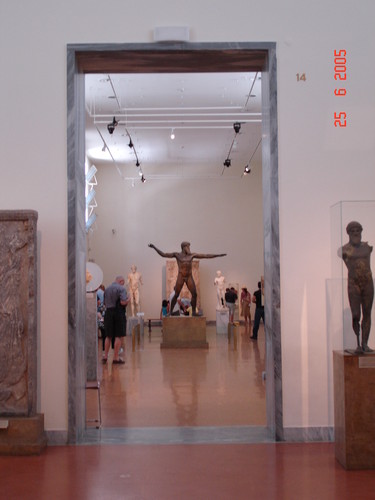
E só a fachada do edificio já deslumbra, com a sua arquitectura típicamente grega, a começar pelas quatro colunas ao centro. Percebemos no entanto que estamos perante um edificio de construção recente e confirmamos depois que foi feito no século XIX.
Ao entrar começamos a "navegar" pelas várias colecções, pela pré-história, o período Neolítico, a idade do bronze, a vários objectos e estátuas que suportam a mitologia grega.
And just the facade of the building dazzles with its typically Greek architecture, starting with four columns in the center. We realize however that we are in front of a building of recent construction and later confirmed that it was done in the nineteenth century.
Going in we begin to "navigate" through the various collections, the prehistory, the Neolithic Age, the Bronze Age, several objects and statues that support the Greek mythology.
Ao entrar começamos a "navegar" pelas várias colecções, pela pré-história, o período Neolítico, a idade do bronze, a vários objectos e estátuas que suportam a mitologia grega.
And just the facade of the building dazzles with its typically Greek architecture, starting with four columns in the center. We realize however that we are in front of a building of recent construction and later confirmed that it was done in the nineteenth century.
Going in we begin to "navigate" through the various collections, the prehistory, the Neolithic Age, the Bronze Age, several objects and statues that support the Greek mythology.
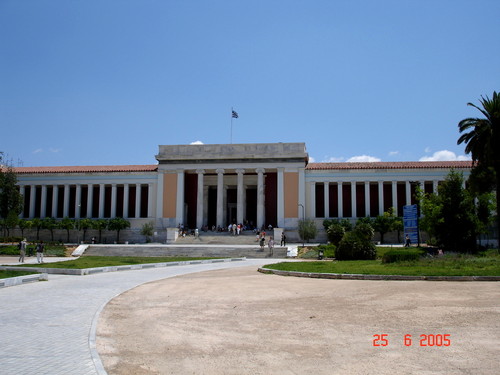
Logo das primeiras estátuas a impressionar é a de um Kouros, que representavam os jovens do sexo masculino, de porte atlético e muitas vezes o termo Kouros era utilizado como equivalente a soldado.
Ao longe já se destacava uma estátua de bronze de Artemision. A dúvida fica no ar, será Zeus ou Poseidón?
O que lhe está a faltar na mão seria a chave do segredo, um raio ou tridente definiria quem era o ilustrado desta magnifica estátua a uma escala quase real.
Right away the first statues to impress are that of Kouros, who represented the young men of athletic build and often the term Kouros was used as the equivalent soldier.
In the distance stood out a bronze statue of Artemision. The question hangs in the air, is it Zeus or Poseidon?
What is missing in it's hand would be the secret key, lightning or trident would define who was illustrated in this magnificent statue on a scale almost real.
In the distance stood out a bronze statue of Artemision. The question hangs in the air, is it Zeus or Poseidon?
What is missing in it's hand would be the secret key, lightning or trident would define who was illustrated in this magnificent statue on a scale almost real.
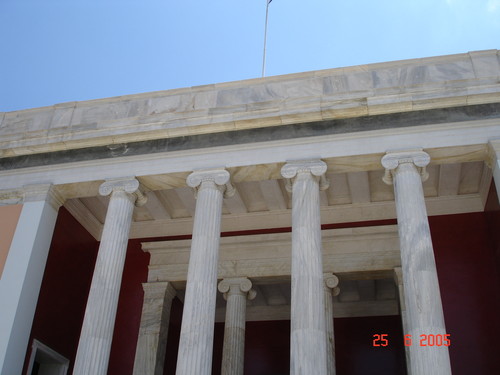
>>> Kouros
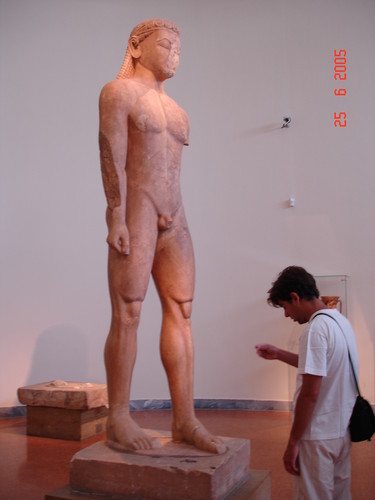
>>> Artemision
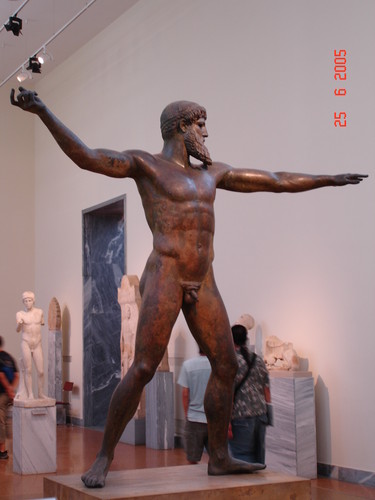
A seguir entramos numa sala cujo vermelho da parede faz sobressair o branco das estátuas que ali estão, assim como uma de bronze que se destaque.
Encontramos o Diadúmeno, o atleta vencedor. A fita á volta do cabelo e o manto junto á estátua deste jovem atleta são as provas de que saiu vitorioso. Foi encontrado na ilha de Delos.
Destacava-se no meio da sala esta estátua de bronze do período helénico, que representa o jovem joquei de Artémis.
Creio que a foto não lhe fará justiça, ao vivo é muito mais interessante. A mão do rapaz que parece andar á solta estaria na realidade a segurar as rédeas ou as crinas do cavalo, na outra estaria um chicote.
A seguir vimos a estátua de Afrodite, a deusa do amor e da beleza.
Then we entered a room whose red wall brings out the white of the statues that are there, as well as a bronze stand.
We found the Diadúmeno, the athlete winner. The ribbon around his hair and mantle near the statue of this young athlete is the evidence that he emerged victorious. It was Found on the island of Delos.
Stood out in the middle of the room this bronze statue of the Greek period, which represents the young jockey Artemis.
I think the photo does not do justice, to see it live is much more interesting. The hand of the guy who seems to be loose was actually holding the reins or the horse's mane, the other would be a whip.
Then we saw the statue of Aphrodite, the goddess of love and beauty.
Then we entered a room whose red wall brings out the white of the statues that are there, as well as a bronze stand.
We found the Diadúmeno, the athlete winner. The ribbon around his hair and mantle near the statue of this young athlete is the evidence that he emerged victorious. It was Found on the island of Delos.
Stood out in the middle of the room this bronze statue of the Greek period, which represents the young jockey Artemis.
I think the photo does not do justice, to see it live is much more interesting. The hand of the guy who seems to be loose was actually holding the reins or the horse's mane, the other would be a whip.
Then we saw the statue of Aphrodite, the goddess of love and beauty.
>>> Diadúmeno
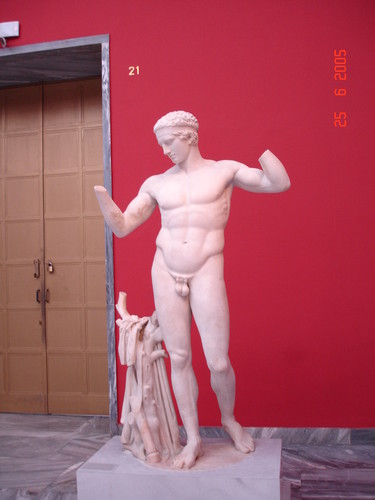
>>> Joquei de Artémis
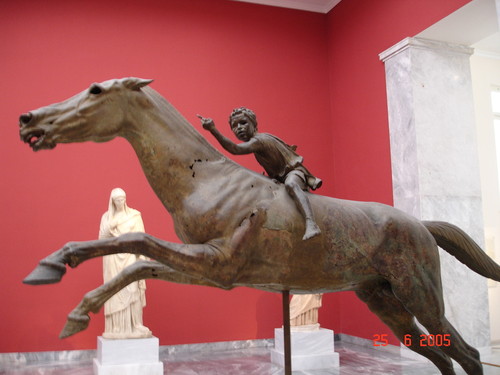
>>> Afrodite
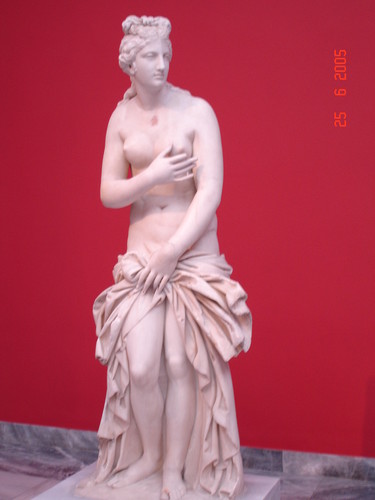
Encontramos depois uma parte de um pequeno templo fúnebre de Aristonauta, foi encontrado num antigo cemitério de Kerameikos em Atenas. O nome do guerreiro está inscrito na pedra.
We find then a part of a small funeral temple of Aristonauta, iwas found in an ancient cemetery of Kerameikos in Athens. The warrior's name is inscribed on the Stone.
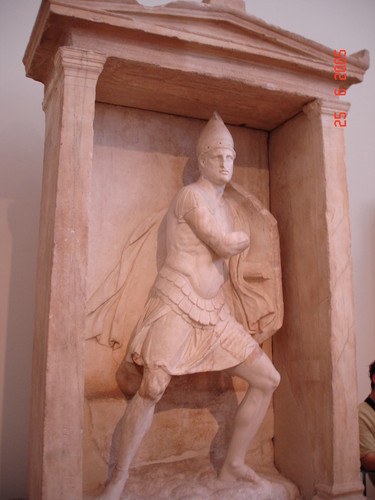
Segue-se uma cabeça que se acredita ser de uma estátua de Higéia, a filha de Esculápio, o Deus da Medicina e da Cura na mitologia grega. Ela tal como o seu pai era uma deusa ligada á saúde, ela seria para a prevenção e o pai para a cura.
Here is a head believed to be of a statue of Hygeia, the daughter of Aesculapius, the God of Medicine and Healing in Greek mythology. She like his father was a goddess linked to health, she would represent the prevention and he the cure.
Here is a head believed to be of a statue of Hygeia, the daughter of Aesculapius, the God of Medicine and Healing in Greek mythology. She like his father was a goddess linked to health, she would represent the prevention and he the cure.
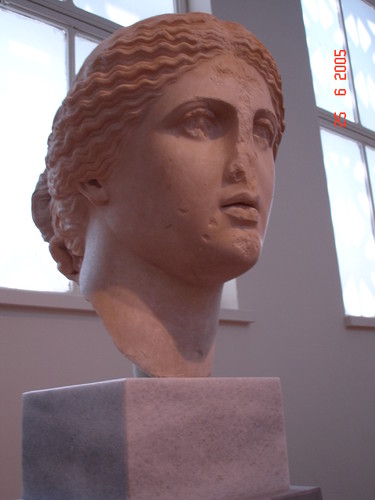
Segue-se mais uma estátua de Bronze, a Ephebe. Acredita-se que poderá ser uma representação de Perseu e que na sua mão estaria a cabeça da Medusa, já que foi ele que a decapitou. Ele era o filho mortal de o deus dos deuses gregos, Zeus.
Por outro lado, poderia ser Páris e na sua mão estaria a Maçã da Discórdia, oferecendo-a a Afrodite. Páris, é o famoso rapaz que se apaixona pela bela Helena, mulher do Rei de Esparta. Daqui nasce a história do Cavalo de Tróia.
Below there is another Bronze statue, Ephebe. It is believed that it may be a representation of Perseus and his hand was in Medusa's head, since he was the one that beheaded it. He was the mortal son of the god of the Greek gods, Zeus.
On the other hand, could be Páris, and on his hand would be the Apple of Discord, offering it to Aphrodite. Paris is the famous boy who falls for the beautiful Helen, wife of the King of Sparta. Hence the story of the Trojan Horse.
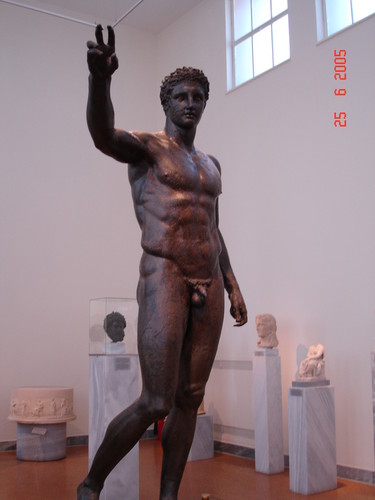
Esta estátua achei ternurenta, encontrámos muitas estátuas de homens e mulheres, deuses e deusas, esta representa uma criança carregando o seu cãozinho.
This statue found quite tender, we found many statues of men and women, gods and goddesses, this is of a child carrying her dog.
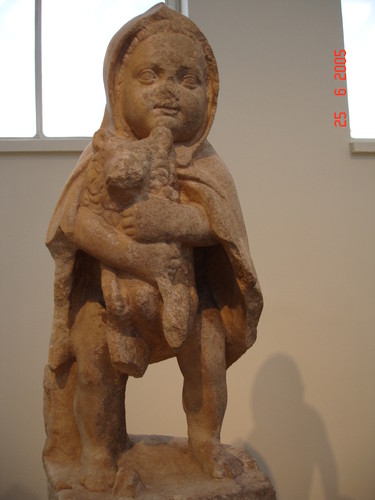
Entramos agora na era romana com uma estátua de Augustus, o imperador romano. O homem que não olhando a meios para atingir os seus fins, acabou por ser um bom governante e levar o império romano a ser mais próspero e estável.
We have now entered the Roman era with a statue of Augustus, the Roman emperor. The man who does not look at means to achieve the ends, turned out to be a good ruler and brought the Roman Empire to be more prosperous and stable.
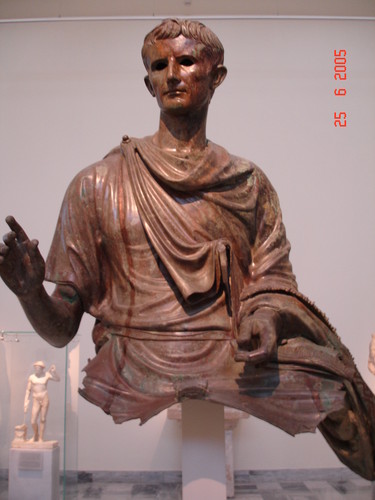
Também do período romano surge um sarcófago de mármore e mostra a caça ao javali Calidón.
Ainda neste período encontramos uma estátua de metal de um atleta em pleno lançamento do disco. Esta é uma das provas olímpicas mais antigas que surgiu na Grécia.
Also from the Roman period there is a marble sarcophagus and it shows the Calydon boar hunt.
In between we find a metal statue of an athlete on full discus throw. This is one of the oldest Olympic events that arose in Greece.
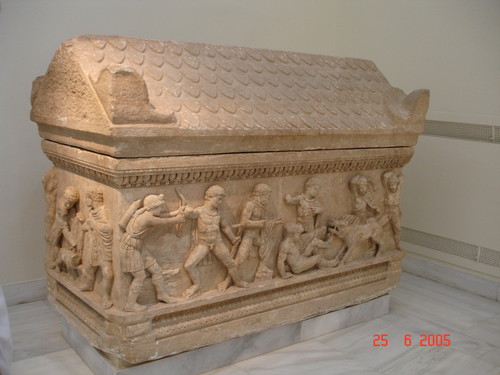
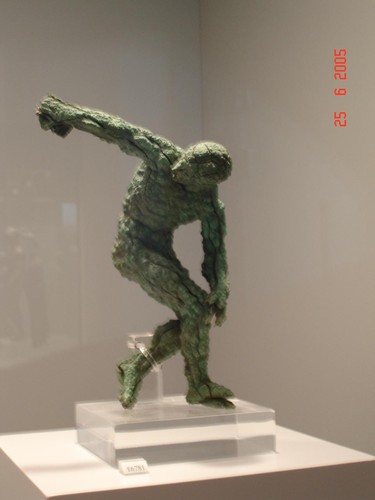
Há muito para ver neste museu, muitas histórias e épocas que se cruzam, fomos pouco tempo mas ainda assim aproveitámos muito.
There is plenty to see in this museum many times and stories that intersect, we recently took advantage quite yet.
Website: http://www.namuseum.gr/wellcome-en.html
There is plenty to see in this museum many times and stories that intersect, we recently took advantage quite yet.
Website: http://www.namuseum.gr/wellcome-en.html
Mais
posts/More posts:


Sem comentários:
Enviar um comentário